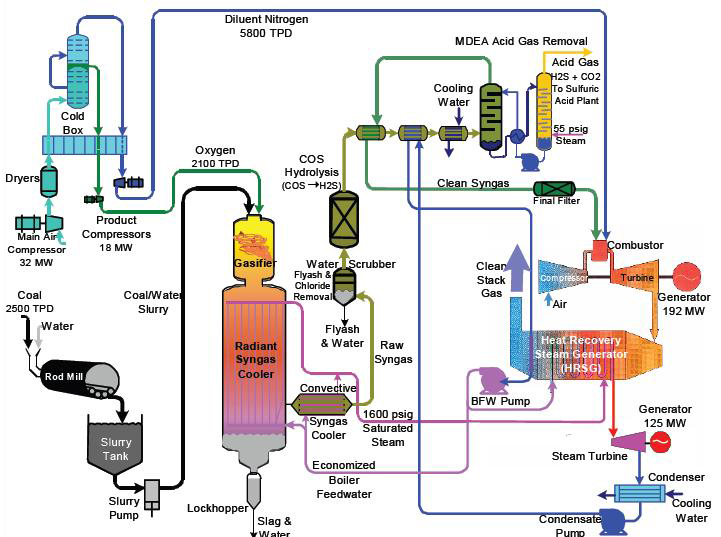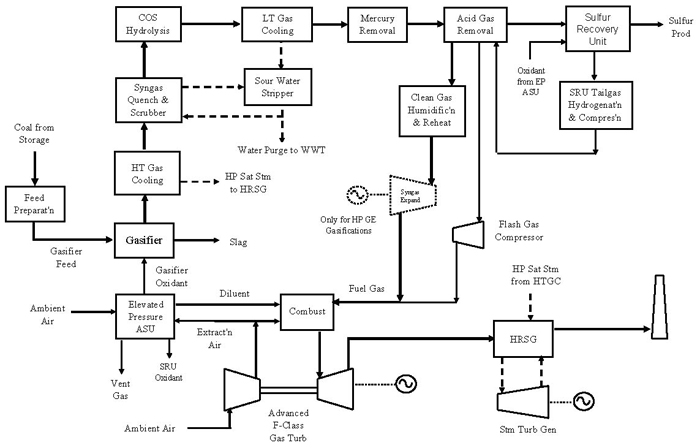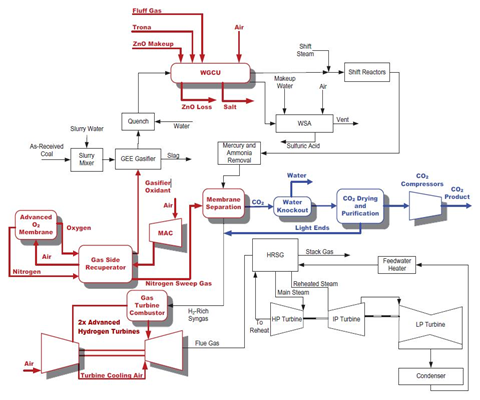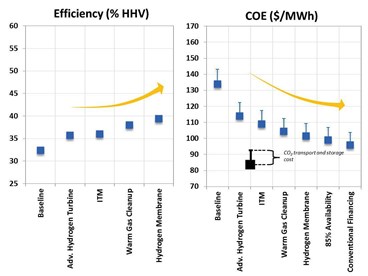Typical Integrated Gasification Combined Cycle (IGCC) Configuration | Coal Gasification
by Rudy P. SysAdmin at howtofindthemoneyMajor Commercial Examples of IGCC Plants
While there are many coal gasification plants in the world producing electricity, fuels, chemicals and/or steam, the following are seven notable, commercial-size IGCC plants for producing electricity from coal and/or coke.

Figure 1: Tampa Electric IGCC Process Flow
Figure 2 shows a simplified block flow diagram (BFD) illustrating the major process sub-systems included in an IGCC plant. The BFD shows an elevated-pressure (EP) air separation unit (ASU) integrated to the gas turbine (GT) operation by extracting some of the GT air compressor discharge as feed to reduce the ASU air compressor size and power consumption. The six operating IGCC plants cited, with the exception of the Wabash plant and Nakoso plant, all have EP ASU integration with the GT. The Buggenum and the Puertollano IGCC plants were designed with EP ASU/GT integration while the Tampa IGCC was modified in 2005 for EP ASU/GT integration; Edwardsport IGCC closely follows current Tampa IGCC design. Oxygen-depleted nitrogen from the EP ASU is compressed back to the GT as diluents for nitrogen oxide (NOx) control, and to maintain mass flow through the GT. Kemper County IGCC is to utilize air-blown transport gasification and Nakoso IGCC is also air-blown, and therefore do not incorporate an ASU.

Figure 2 : IGCC Block Flow Diagram
A more detailed process description of each of the processing units within an IGCC complex is presented in the discussion on IGCC process system sections.
* Closure of the 250 MW IGCC located in Buggenum, The Netherlands dictated by changing power market in the European Union.
Effect of CO2 Capture
The flow scheme of Figure 2 represents a typical process arrangement of a near-term commercial IGCC design without CO2 capture. CO2 capture and sequestration (CCS) significantly impacts the overall IGCC efficiency, and the effects are addressed in the discussion Designs for CO2 Capture.
Advanced IGCC
DOE’s R&D program is targeting advances in technologies that will improve upon the conventional IGCC technology discussed above. Cumulatively, the technology advances will produce electric power more efficiently and significantly lower the COE. An IGCC cycle including carbon capture that incorporates these advanced technologies is depicted in Figure 3. The impact of each technology on both process performance and cost are being evaluated, and by way of summary the following technological advances and their benefits are expected1:
- Advanced hydrogen turbine (AHT): The AHT replaces the state-of-the-art F-class turbine (F-class is currently used at Tampa, Wabash River, and is depicted in the baseline IGCC in Figure 2). Its higher firing temperature (~2650°F) both improves the process efficiency and results in ~45% increase in gas turbine output, mandating increased flow rates such as coal input and significantly boosting power capacity. Plant units are larger to accommodate the increases, resulting in economies of scale which deliver unit capital cost reductions. Quantitatively, upgrading the turbine decreases COE 14.5% and increases process efficiency by 3 percentage points.
- Ion transport membrane (ITM) for oxygen production: The ITM-based oxygen unit replaces the conventionally used cryogenic ASU. The ITM provides more energy efficient separation than the ASU, but the auxiliary duty for compression of the inlet air and low-pressure oxygen results in net power consumption similar to the ASU. The significant advantage of the ITM is that the targeted cost is approximately two-thirds of the ASU, which significantly reduces the capital costs and results in a 3% reduction in COE. Configurations including air-side integration with the turbine are anticipated to further increase the efficiency and COE benefits of the ITM.
- Warm gas clean up (WGCU): This system replaces the desulfurization Selexol stage, mercury removal process, water-gas shift reactor and Claus plant, performing all of these operations at elevated temperatures which allows for the syngas to be cleaned without the associated decrease in efficiency from cooling and reheating the fuel gas stream. Implementing the WGCU process train results in a 2 percentage point increase in net plant efficiency, which is mostly the result of increased power generation from the steam turbine via increased heat recovery from the process. A 4% decrease in COE is also realized.
- Hydrogen membrane for pre-combustion capture: Palladium-based 100% hydrogen-selective membrane replaces the Selexol stage for CO2 capture from the syngas. Use of the palladium membrane improves plant efficiency by 1.4 percentage points mostly from the lower compression costs of CO2. The COE is further reduced by 3%, again mostly due to lower compression costs. NETL is also performing analysis of alternative advanced pre-combustion technologies such as low cost polymer-based membranes and solid sorbents, which would benefit from pairing with WGCU and production of CO2 at elevated pressure.

Figure 3 : Advanced IGCC Plant incorporating DOE/NETL-supported advanced technologies
Successful implementation and integration of all these advanced technologies allows for an estimated increase of 7.0 percentage points in efficiency, as shown in Figure 4. Coupled with increased availability and improved financing structure, a reduction of 28% in COE relative to the state-of-the-art carbon capture IGCC plant has also been estimated.

Figure 4. Cumulative Impact of advanced IGCC technology on net plant efficiency and COE
The 10 largest coal producers and exporters in Indonesia:
Sponsor Ads
Created on Jul 16th 2019 08:00. Viewed 2,414 times.
Comments
No comment, be the first to comment.



